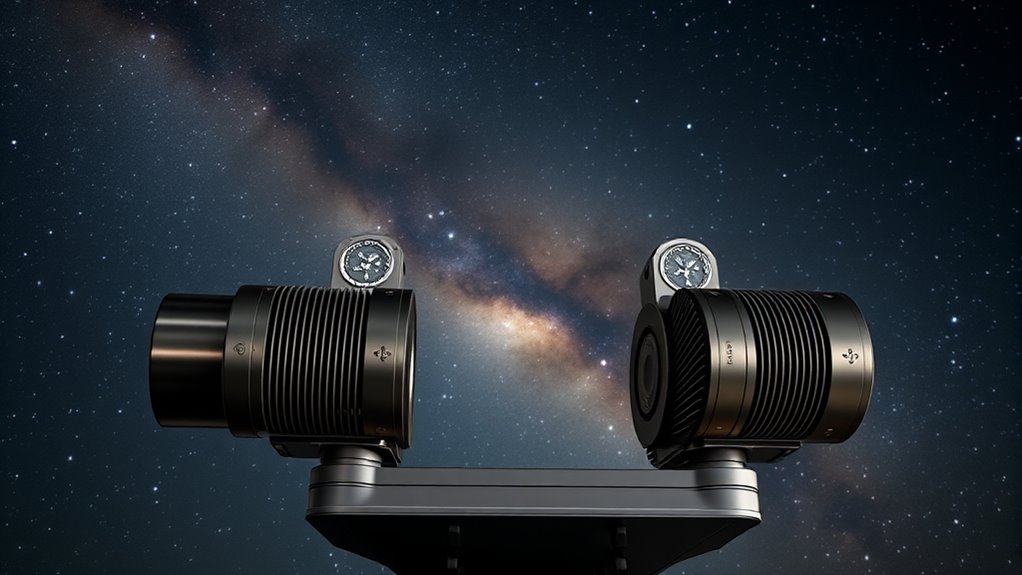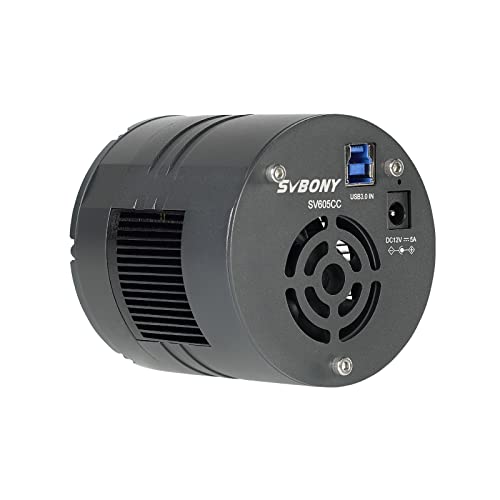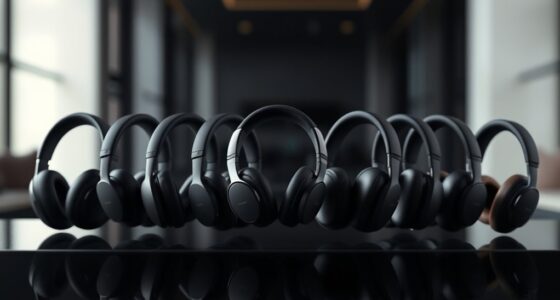For deep sky imaging in 2025, I recommend the SVBONY SV605CC and the Astromania SGCMOS series. The SV605CC offers a high-sensitivity 9MP sensor with dual TEC cooling, ensuring low noise during long exposures, while the Astromania model features a durable aluminum housing and excellent cooling performance. Both cameras support multiple platforms and come with robust software compatibility. If you want to discover more about how these options can elevate your astrophotography, keep exploring the details.
Key Takeaways
- The SVBONY SV605CC offers a high-sensitivity 9MP CMOS sensor with dual-layer TEC cooling for noise reduction in deep sky imaging.
- The Astromania SGCMOS series features durable aluminum housing, high frame rates, and effective cooling ideal for long-exposure astrophotography.
- Both cameras support broad software compatibility (Windows, Linux, Mac, Raspberry Pi) with native, ASCOM, and WDM drivers for seamless integration.
- TEC cooling technology in these cameras reduces sensor temperature by up to 30°C, minimizing thermal noise during extended imaging sessions.
- Their robust build quality, advanced cooling, and high-resolution sensors make them the top choices for serious deep sky astrophotographers in 2025.
SVBONY SV605CC Cooled Camera, 9MP CMOS Telescope Camera
If you’re serious about deep sky astrophotography but want a budget-friendly option, the SVBONY SV605CC cooled camera is a great choice. It features a 9MP CMOS sensor with a 1-inch IMX533 chip, delivering sharp, detailed images of nebulae and galaxies. The dual-layer TEC cooling reduces sensor temperature by 30°C, minimizing noise during long exposures. Its compatibility with Windows, Linux, Mac, Chrome OS, and Raspberry Pi makes it versatile for indoor or outdoor use. With Wi-Fi connectivity, remote control, and a compact design, it’s easy to set up and transport. While not perfect, it offers impressive value for amateur astrophotographers seeking quality imaging on a budget.
Best For: amateur astrophotographers seeking an affordable, versatile cooled camera for deep sky imaging with user-friendly features.
Pros:
- Affordable price point with good resolution for deep sky photography
- Compatible with multiple operating systems including Windows, Linux, Mac, Chrome OS, and Raspberry Pi
- Effective dual-layer TEC cooling reduces sensor temperature, minimizing noise during long exposures
Cons:
- Inconsistent cooling performance and higher noise levels reported by some users
- Loud fan noise may affect outdoor use and overall experience
- Image quality and reliability may fall short compared to higher-end or professional models
Astromania SGCMOS Series Telescope CMOS Camera
The Astromania SGCMOS Series Telescope CMOS Camera is an excellent choice for astrophotographers seeking high sensitivity and versatile imaging options. It features a carefully selected high-sensitivity sensor, fast frame rates, and long exposure capabilities, making it ideal for auto-guiding and multicolour imaging. Its robust aluminum CNC housing ensures durability and efficient heat dissipation, maintaining peak performance. The camera’s standard 1.25-inch interface and inner C-mount provide compatibility with eyepieces and industrial lenses. With built-in ST4 auto-guiding port and seamless software support via native, ASCOM, and WDM drivers, it simplifies integration and enhances your deep-sky imaging experience.
Best For: amateur and professional astrophotographers seeking a versatile, high-sensitivity CMOS camera for auto-guiding and multicolour deep-sky imaging.
Pros:
- High sensitivity sensor with fast frame rate and long exposure capabilities for detailed astrophotography.
- Robust aluminum CNC housing with efficient heat dissipation ensures durability and optimal performance.
- Seamless compatibility with multiple software platforms via native, ASCOM, and WDM drivers simplifies integration.
Cons:
- May require additional accessories like filters and specific adapters for specialized imaging.
- USB 2.0 connection could limit data transfer speed for very high-resolution imaging.
- Slightly heavier and larger compared to more compact guide cameras, which may affect certain setups.
Factors to Consider When Choosing Cooled CMOS Astro Cameras for Deep Sky Imaging

When selecting a cooled CMOS astro camera, I focus on sensor sensitivity and resolution to capture fine details, while cooling performance helps diminish noise for clearer images. Compatibility with your software and ease of setup are also key to a smooth imaging experience, along with sturdy build quality for long-term use. Considering these factors ensures I choose a camera that meets my deep sky imaging needs effectively.
Sensor Sensitivity and Resolution
How do sensor sensitivity and resolution influence your choice of cooled CMOS astro cameras for deep sky imaging? Sensor sensitivity, measured by quantum efficiency (QE), determines how effectively a camera captures faint light. Higher QE (up to 80%) means you can image dim objects like distant galaxies with shorter exposures, saving time and reducing noise. Resolution, determined by pixel count and size, affects image detail; larger pixel counts and smaller pixels enable finer detail and sharper images. For deep sky imaging, a high-resolution sensor (9MP or more) helps reveal intricate structures in nebulae and galaxies. However, increasing resolution can sometimes reduce sensitivity if pixel size shrinks too much. Balancing sensitivity and resolution is essential to optimize image quality, especially when capturing faint celestial objects.
Cooling Effectiveness and Noise
Choosing a cooled CMOS astro camera for deep sky imaging hinges not only on sensor sensitivity and resolution but also on cooling effectiveness. Effective cooling typically lowers sensor temperature by 20°C to 30°C below ambient, which markedly reduces thermal noise during long exposures. The cooling system’s efficiency is vital; inadequate cooling can lead to higher dark current and increased noise levels, degrading image quality. Technologies like TEC and dual-stage refrigeration help achieve stable, low sensor temperatures. If cooling performance is inconsistent or temperature regulation is insufficient, noise levels can fluctuate, impacting the consistency of your results. Maintaining a steady, low sensor temperature—especially in warmer environments—is essential for minimizing noise and ensuring clear, detailed images over extended imaging sessions.
Compatibility With Software
Ensuring your cooled CMOS astro camera is compatible with your preferred software is vital for smooth and efficient deep sky imaging. I look for cameras that support popular programs like SharpCap, ASCOM, or INDI, which guarantees seamless integration. Compatibility with multiple operating systems—Windows, Linux, Mac OS, Chrome OS, or Raspberry Pi—broadens my options and increases flexibility. I also check if the camera offers native drivers or third-party support to confirm reliable communication with my software. Features like live stacking, dark frame calibration, and raw data output are essential for advanced processing. Lastly, I verify that the camera’s software receives regular updates and has strong community support, guaranteeing ongoing compatibility and troubleshooting assistance when needed.
Ease of Setup and Use
When selecting a cooled CMOS astro camera, ease of setup and use are crucial factors that can save you time and frustration. I look for cameras with intuitive interfaces and clear, detailed manuals that make initial configuration straightforward. Compatibility with my operating system’s software and drivers is essential to ensure smooth integration. I also prefer models that come with extensive accessories like connection cables, adapters, and manual controls, which simplify installation. Automatic or semi-automatic cooling systems are a big plus, as they eliminate the need for manual temperature adjustments. Additionally, online tutorials, active community support, and manufacturer resources can be invaluable when troubleshooting or learning new features. These factors collectively help me get started quickly and focus more on capturing stunning deep-sky images.
Build Quality and Durability
A sturdy build quality is essential for cooled CMOS astro cameras, especially when capturing deep sky objects over extended periods. High-quality materials like aluminum CNC housings improve durability and heat dissipation, which helps maintain ideal sensor temperatures. Robust construction protects the camera against environmental factors such as moisture, dust, and temperature swings, extending its lifespan. Well-designed cooling systems with reliable components prevent thermal damage and ensure stable operation during long imaging sessions. Durable connectors, like sturdy USB ports and C-mounts, reduce wear and maintain connection stability over time. Additionally, thorough craftsmanship and strict quality control minimize issues such as fan noise, vibrations, or hardware failures, guaranteeing reliable performance across various conditions and making the investment worthwhile for serious astrophotographers.
Price and Value
Have you ever wondered how to balance cost and performance when choosing a cooled CMOS astro camera for deep sky imaging? Prices can range from a few hundred dollars for entry-level models to over several thousand for professional-grade cameras. But cost isn’t everything—value depends on sensor quality, cooling efficiency, resolution, and software compatibility. Investing in a higher-priced camera often means better cooling, lower noise, and greater durability, which can save you money long-term. Budget options might be suitable for beginners but often lack advanced features like deep cooling or high dynamic range. When evaluating, consider additional costs for accessories, software, and maintenance. Ultimately, choosing the right camera involves weighing your budget against your astrophotography goals and the features that deliver the best long-term value.
Frequently Asked Questions
How Do Cooled CMOS Cameras Compare to CCD Cameras for Deep Sky Imaging?
Cooled CMOS cameras generally offer faster readout speeds and lower power consumption compared to CCDs, making them great for capturing deep sky images quickly. While CCDs often produce slightly better image quality with less noise in long exposures, modern cooled CMOS sensors have improved markedly, providing excellent detail and sensitivity. I find CMOS cameras more versatile for my astrophotography, especially when balancing quality, cost, and convenience.
What Is the Typical Lifespan of Cooled CMOS Astro Cameras’ Cooling Components?
The cooling components in cooled CMOS astro cameras typically last around 5 to 10 years, depending on usage and maintenance. I’ve found that keeping the cooling system clean and avoiding extreme conditions helps prolong their lifespan. Regularly checking for dust or corrosion, and following manufacturer guidelines, ensures your camera stays in top shape. Overall, with proper care, these cooling systems remain dependable for many years of deep sky imaging.
Can Cooled CMOS Cameras Be Used Effectively With Amateur Telescopes?
Absolutely, cooled CMOS cameras are like trusty companions on your amateur telescope journey. I’ve found they integrate seamlessly, enhancing clarity and detail in my astrophotography. Their versatility means you don’t need professional-grade gear to start capturing stunning deep sky images. Just make certain your telescope’s mount can handle the camera’s weight and that you’ve got proper adapters. With patience, these cameras turn your backyard into a professional observatory.
How Important Is Sensor Size When Selecting a Cooled CMOS Astro Camera?
Sensor size is pretty critical when choosing a cooled CMOS astro camera because it directly affects your field of view and image resolution. A larger sensor captures more sky, which is great for wide-field imaging and deep-sky objects. I always consider this aspect because it impacts how much of the sky I can see in a single shot, ultimately improving my astrophotography results.
Are There Any Specific Software Requirements for Operating Cooled CMOS Astro Cameras?
Imagine a control panel glowing softly as I connect my cooled CMOS camera. Most cameras require specific software, often provided by manufacturers, to operate smoothly. I make certain my software is compatible with my computer’s OS and supports features like live stacking and auto-guiding. Sometimes, updates or drivers are essential to optimize performance. Staying current with software ensures my camera captures the cosmos’s wonders without a hitch.
Conclusion
Choosing the right cooled CMOS astro camera can feel overwhelming, but it’s about balancing performance with value. While the SVBONY SV605CC offers impressive resolution and cooling, the Astromania SGCMOS shines in ease of use and affordability. Both excel in their own way, proving that you don’t need to break the bank to capture stunning deep sky images. Sometimes, the perfect camera isn’t the most advanced—just the one that fits your needs best.
Alfons is the visionary leader and driving force behind Voyager Info’s success. As the Editor in Chief, he brings a wealth of experience and an unwavering passion for travel to the helm of our cruise-centric platform.
With a lifelong fascination for exploring new horizons, Alfons discovered his love for the ocean and cruising at a young age. From sailing across pristine Caribbean waters to embarking on daring expeditions to far-flung destinations, he has amassed a treasure trove of first-hand experiences in the world of cruising.













